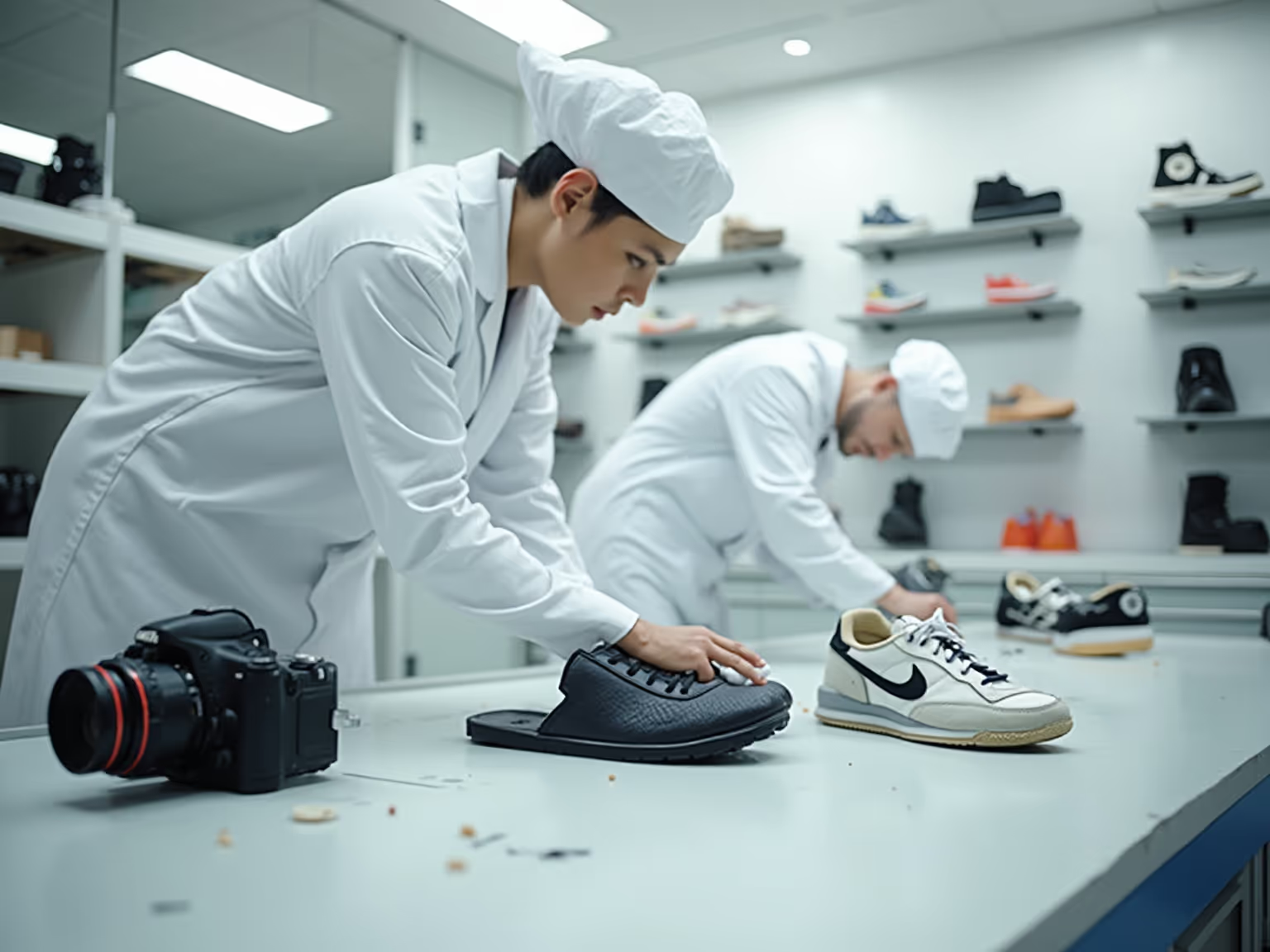How to Conduct a Thorough Footwear Inspection: A Step-by-Step Guide
Learn essential steps for effective footwear inspection to ensure quality and safety standards.

Overview:
To conduct a thorough footwear inspection, one must follow a structured process that includes preparation, visual inspection, measurement, material evaluation, functionality testing, and final reporting. The article emphasizes the importance of each step in ensuring quality and safety, detailing how meticulous documentation and adherence to standards like the Acceptable Quality Level (AQL) can significantly enhance product integrity and customer satisfaction.
Key Highlights:
- Preparation involves gathering essential tools like measuring tape, checklists, and documentation for a structured inspection process.
- Visual inspection requires checking for defects such as scuffs, scratches, and verifying stitching, logos, and labels for quality.
- Measurements should confirm shoe dimensions align with manufacturer's specifications to prevent fit and comfort issues.
- Materials must meet quality standards for durability and should match advertised specifications, with a focus on sustainability.
- Functionality testing includes wearing the shoes to assess comfort and fit, crucial for effective risk management.
- Final reviews compile findings into a report, including photographs and notes, to support continuous improvement efforts.
- The Acceptable Quality Level (AQL) framework guides inspectors in determining acceptable defect rates during random sampling.
- Key evaluation criteria include material quality, fit testing, durability tests, comfort assessment, and aesthetic evaluation.
- Common defects to monitor include stitching errors, sole separation, misaligned components, color discrepancies, and odors.
- Documentation should involve checklists, detailed notes, summary reports, and recommended follow-up actions for identified defects.
- Implementing quality control measures involves regular training, standards audits, supplier evaluations, and establishing feedback loops.
Introduction
In the competitive landscape of the footwear industry, maintaining high-quality standards is not just a matter of compliance; it is essential for brand reputation and customer satisfaction. As consumers become increasingly discerning, the importance of thorough footwear inspections cannot be overstated.
This article delves into the critical steps involved in conducting a comprehensive footwear inspection, highlighting key criteria for evaluating quality, identifying common defects, and emphasizing the necessity of meticulous documentation.
By implementing robust quality control measures, brands can not only safeguard their products but also enhance their market position, ensuring that they meet both consumer expectations and industry standards.
Through expert insights and practical guidance, this piece offers a roadmap for brands aiming to elevate their quality assurance practices and drive continuous improvement in footwear production.
Essential Steps in Conducting a Footwear Inspection
To ensure the highest quality and safety standards in protective shoes, follow these essential steps for a thorough examination:
-
Preparation: Start by collecting all essential tools, such as a measuring tape, a checklist for assessment, and any pertinent documentation related to the shoes. This foundational step is crucial for a structured footwear inspection process.
-
Visual Inspection: Conduct a meticulous visual examination of the shoes. Look for obvious defects like scuffs, scratches, or misalignments. Attention to detail is vital—perform a footwear inspection to check the stitching, logos, and labels for authenticity and quality.
-
Measurement: Utilize a measuring tape to confirm the dimensions of the shoes. Measure the length, width, and height, ensuring they align with the manufacturer's specifications. Accurate measurements are essential to prevent issues related to fit and comfort.
-
Material Check: Evaluate the materials used in the construction of the shoes. It is critical that these materials meet established quality standards and correspond with the advertised specifications. Quality materials are foundational to durability and customer satisfaction.
-
Functionality Testing: Evaluate the shoes' functionality by putting them on and walking around. This practical test allows you to evaluate comfort, fit, and any potential movement issues. Effective risk management in shoe production relies on performing thorough footwear inspections to ensure that the product performs as expected in real-world scenarios.
-
Final Review: Compile your findings into a comprehensive report that details any issues or concerns identified during the examination. This report should include photographs and thorough notes, serving as a valuable reference for continuous improvement efforts. By recording these findings, you aid in a culture of assurance that encompasses dynamic controls and supplier self-QC programs, crucial elements of effective risk management in shoe production. The comprehensive report, enriched with photos and videos, enhances transparency and accountability, making it easier to address any identified issues in the footwear inspection process.
The Acceptable Quality Level (AQL) is a critical framework in this footwear inspection, as it sets the standards for the maximum number of defective items considered acceptable during random sampling. AQL numbers guide inspectors on the number of items to test, ensuring that the products consistently meet quality expectations. This understanding is essential for D2C owners, as it assists them in maintaining high-quality standards and safeguarding their reputation.
As emphasized by industry experts like Eric Neuner, founder of NuShoe Inc., who states,
Trust NuShoe Inspect & Correct to keep your shoes in prime condition.
Following these steps not only improves standards but also protects your brand from negative feedback and customer problems, aiding ongoing efforts in risk management and continuous enhancement in shoe production. The significance of thorough evaluations is highlighted by the relevance of these practices in the industry, demonstrating a dedication to excellence.

Key Criteria for Evaluating Footwear Quality
When evaluating shoe standards, it is essential to take into account several important factors that not only improve the product's performance but also correspond with changing consumer preferences, especially considering the Shoe & Footwear Manufacturing sector's anticipated drop in revenue at a CAGR of 3.4% from 2019 to 2024. Leveraging tailored quality inspections from OpsNinja can further strengthen these assessments:
-
Material Quality: The selection of materials plays a pivotal role in shoe performance. Evaluate the upper, lining, and sole materials for their durability and comfort. Opt for high-quality materials, such as genuine leather or premium synthetics, known for their resistance to wear and tear. This emphasis on material integrity is becoming more crucial as sustainable practices transform industry standards, addressing increased consumer environmental awareness. As noted by industry experts, "Sustainable footwear is reshaping the industry," highlighting the significance of eco-friendly practices in material selection. OpsNinja’s customized quality checks can ensure that these materials meet the highest standards.
-
Fit Testing: Achieving the right fit is essential for customer satisfaction. Footwear should neither be excessively tight nor loose, and designs must accommodate the natural contours of the foot. Proper fit testing mitigates return rates and enhances overall customer experience, directly impacting sales. OpsNinja’s footwear inspection helps streamline this process, ensuring that the fit aligns with consumer expectations.
-
Durability Tests: Conduct rigorous durability tests to evaluate the longevity of the shoes. These tests should include stress evaluations on seams and soles to ensure they can endure regular usage. A commitment to durability not only supports consumer confidence but also reduces long-term costs associated with returns and replacements. OpsNinja’s tailored approach enhances these evaluations, which include footwear inspection, reinforcing brand reliability.
-
Comfort Assessment: Comfort is a critical factor for consumers, especially for those who wear footwear for extended periods. Assess the quality of insoles and cushioning, ensuring they provide adequate support. Recent studies indicate that comfort significantly influences purchasing decisions, making this assessment vital for competitive positioning. OpsNinja’s focus on comprehensive footwear inspection ensures that comfort standards are effectively met.
-
Aesthetic Evaluation: Lastly, the visual appeal of the footwear should not be overlooked. Assess the overall look, ensuring a clean finish and a design that aligns with current trends while remaining true to the identity. A well-executed aesthetic can enhance marketability and attract discerning consumers, bolstering sales in a competitive landscape. Considering the intense competition and evolving consumer preferences, ensuring assessment in these areas is crucial for sustaining a competitive advantage.
By merging these evaluations with OpsNinja's specialized advice, as demonstrated in the case study showcasing entrepreneur Neil Ayton, who effectively handled various suppliers and control procedures for his collection of e-commerce ventures, D2C enterprises can refine their control processes, improve customer satisfaction, and boost revenue recovery. OpsNinja’s customized checklist assistance, which encompasses particular assessments including footwear inspection for different types of shoes, further guarantees that brands safeguard themselves from unfavorable reviews and consumer experiences.

Common Defects to Look For
During your inspection, it is crucial to identify the following common defects that can significantly affect the quality and safety of protective footwear:
-
Stitching Errors: Pay close attention to loose threads, uneven stitches, or skipped stitches. These issues can severely compromise the durability and lifespan of the shoes, making it essential to address them promptly. Industry experts have indicated that stitching errors are among the most prevalent defects in footwear manufacturing, leading to increased returns and customer dissatisfaction. OpsNinja’s thorough evaluation reports, which feature photos and videos, can assist you in recognizing these issues early, safeguarding your reputation from negative feedback.
-
Sole Separation: Inspect whether the sole is firmly attached to the upper section of the shoe. Any signs of separation may indicate inferior craftsmanship and can lead to safety hazards for the wearer. Ensuring a solid bond between these components is vital for maintaining product integrity. Customer testimonials emphasize how OpsNinja's detailed evaluations have allowed brands to address such problems before products reach the market. As one pleased client noted, 'OpsNinja's evaluations saved us from possible customer complaints by identifying sole separation issues early.'
-
Misaligned Components: Confirm that all parts of the shoes, including eyelets, straps, and seams, are correctly aligned and function as intended. Misalignment can affect not only the aesthetics of the shoe but also its overall functionality and comfort. OpsNinja’s expert footwear inspection ensures that these components meet high standards, reducing the risk of customer complaints.
-
Color Discrepancies: Verify that the footwear color aligns with the specifications provided. Variations in color can signify underlying quality control issues and can detract from the perceived value of the product. Utilizing OpsNinja’s inspection services can help maintain color consistency, further enhancing trust in the company.
-
Odors: Be vigilant for any unpleasant smells emanating from the footwear, which can indicate the use of substandard materials or flawed manufacturing processes. Footwear should be free from any chemical or moldy odors, as these can impact customer satisfaction and brand reputation. Frequent evaluations by OpsNinja can reduce these risks, ensuring an optimal product experience for your customers.
Additionally, it's important to recognize that fitting issues, such as those highlighted in the J Foot Ankle Res, are prevalent across various demographics, including individuals with diabetes. Routine evaluations concentrating on these typical flaws are crucial for upholding high-quality standards in footwear inspection for your shoe products. As noted by Eurofins, "expertise in footwear inspection is crucial for identifying and mitigating these issues," ultimately ensuring that products meet customer expectations and maintain your company's reputation.
Moreover, case studies, like the one on peeling leather and surface damage, demonstrate how regular oversight and the use of premium materials can reduce risks linked to these defects. By collaborating with OpsNinja, you can guarantee that your products not only satisfy standards but also safeguard your reputation from adverse customer experiences.

Documentation and Reporting
After finishing your footwear inspection, it is essential to record your findings meticulously. This documentation not only serves as a foundation for quality assurance and ongoing improvement but is also essential in protecting your brand from negative reviews and customer issues, particularly since incorrect sizing can lead to high return rates.
- Evaluation Checklist: Utilize a standardized checklist to systematically document the outcomes of each evaluation step.
This practice ensures consistency and enhances the reliability of your footwear inspection evaluations. A comprehensive checklist for footwear inspection should include criteria such as: - Quantity verification - Packaging assessment - Product style and construction verification - Logo and labeling accuracy - Measurement and fit analysis - Functional performance tests
All of which are crucial for ensuring the durability and safety of footwear. Photographic evidence should include clear photographs of any defects or issues encountered during the footwear inspection.
This visual documentation is invaluable, as it substantiates your findings in reports and facilitates effective communication with your production team. As Eric Neuner, founder of NuShoe Inc., emphasizes,
By choosing NuShoe Inspect & Correct, you’re choosing a partner dedicated to excellence,
underscoring the necessity of high standards in documentation to enhance company reputation.
- Detailed Notes: Maintain comprehensive notes regarding the condition of each pair of shoes inspected.
Include specific concerns, observations, and recommendations for improvement. This level of detail is crucial for footwear inspection, identifying trends and addressing recurring issues efficiently, thereby safeguarding your brand against quality-related complaints.
- Summary Report: Compile your findings into a detailed report that emphasizes the overall standard of the inspected footwear and the footwear inspection process.
This report should include photos, videos, and inspection instructions, outlining patterns or persistent issues that may require the attention of the production team. Insights from case studies such as NuShoe Inspect & Correct's control standards can demonstrate effective documentation practices and their outcomes, highlighting how compliance with these standards boosts customer satisfaction and safeguards your reputation from negative reviews.
- Follow-Up Actions: If defects are identified, it is essential to recommend appropriate follow-up actions.
This could include re-inspection, product recalls, or necessary adjustments to manufacturing processes to mitigate future risks. By following these documentation best practices, you ensure a robust control framework that ultimately enhances customer satisfaction and strengthens your brand reputation, particularly through footwear inspection. To discover how OpsNinja can support you in these efforts, reach out to us today and observe OpsNinja in action, establishing us as your reliable partner in assurance.

Implementing Quality Control Measures
To implement effective control measures in protective footwear production, several strategies must be prioritized:
-
Regular Training: Ongoing training is essential for production staff to comprehend and follow standards and inspection protocols. Given that one in three employees report their organization's training as outdated, it is imperative to provide engaging and updated training methods. As a Senior Copywriter at AMI Group noted,
The training sessions are more engaging than the self-paced modules; it's easier now that I first decided to take up the online classroom training and then followed it up with the self-paced learning.Such approaches not only enhance learning but also improve compliance with standards. Additionally, 87% of L&D professionals emphasize the importance of fostering a growth mindset, which further underscores the necessity of continuous development in control practices. -
Standards Audits: Conducting regular standards audits is essential to assess compliance with established criteria. These audits help identify areas needing improvement and provide a structured approach to maintaining product integrity. Evidence indicates that organizations that conduct thorough audits experience significant enhancements in production efficiency and product safety. OpsNinja's dedicated support team is always prepared to assist in these audits, ensuring thorough evaluations.
-
Supplier Evaluation: It is essential to assess and choose suppliers according to their excellence practices. Ensuring that materials meet the required standards begins with a thorough evaluation of suppliers, which can significantly influence the overall caliber of the finished product. OpsNinja's commitment to impartial assessment ensures that these evaluations are fair and systematic, as demonstrated in various customer success stories.
-
Feedback Loops: Creating feedback loops between inspectors and production teams enables real-time communication regarding issues of standard. This immediate exchange of information allows for prompt adjustments and fosters a responsive production environment, enhancing overall product standards. OpsNinja's dedicated support team plays a crucial role in managing these communication channels effectively, as seen in the transformative experiences shared by clients. A culture of continuous improvement should be cultivated by regularly reviewing footwear inspection processes and adapting them based on findings and industry best practices. The principles of total excellence management advocate for self-assessment as a tool for fostering improvement across all organizational aspects. The case studies showcasing OpsNinja's impact on D2C brands illustrate a holistic framework that interrelates all variables linked to control measures, encouraging managers to adopt a proactive approach to assurance.
Incorporating these measures not only strengthens the assurance process but also aligns with recent statistics indicating that 76% of employees believe companies should provide more digital skills training, yet only 44% report their employers conduct footwear inspection to ensure safety. This gap emphasizes the necessity for organizations to invest in effective training and quality control measures to enhance their production efficacy and ensure safety in protective footwear.

Conclusion
Implementing comprehensive footwear inspections is a critical strategy for maintaining high-quality standards and ensuring customer satisfaction in the competitive footwear industry. By following essential steps such as preparation, visual inspection, and thorough documentation, brands can identify defects early and take corrective actions that enhance product integrity.
Key criteria for evaluating footwear quality—material quality, fit testing, durability, comfort, and aesthetics—underscore the importance of aligning products with consumer preferences. These assessments not only prevent potential returns but also bolster brand reputation, especially in an era where sustainability is becoming increasingly significant.
Recognizing common defects, such as stitching errors and sole separation, further emphasizes the necessity of diligent inspections. By being vigilant and utilizing expert inspection services, brands can mitigate risks associated with quality issues, ultimately safeguarding their market position.
Moreover, meticulous documentation and reporting practices play a pivotal role in the quality assurance process. They create a foundation for continuous improvement, allowing brands to respond proactively to identified issues. Implementing regular training and quality audits reinforces these practices, fostering a culture of excellence that is essential for long-term success.
In conclusion, by prioritizing quality control measures and embracing a commitment to ongoing improvement, footwear brands can not only meet but exceed consumer expectations. This dedication to quality not only protects brand reputation but also drives growth in an increasingly discerning market, ensuring that brands remain competitive and resilient in the face of evolving consumer demands.



